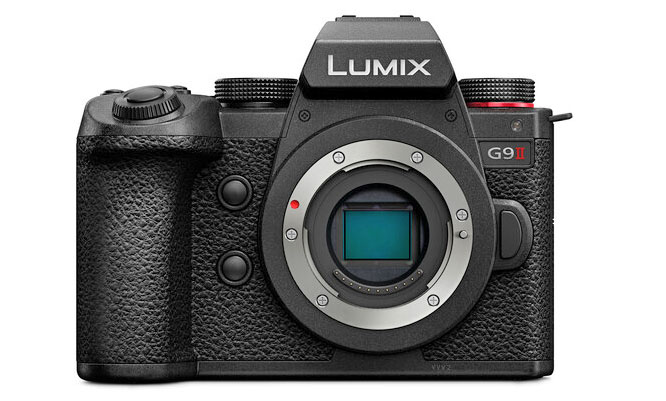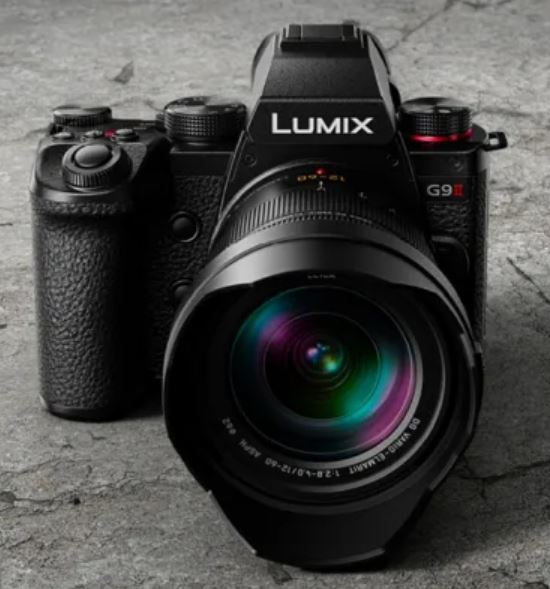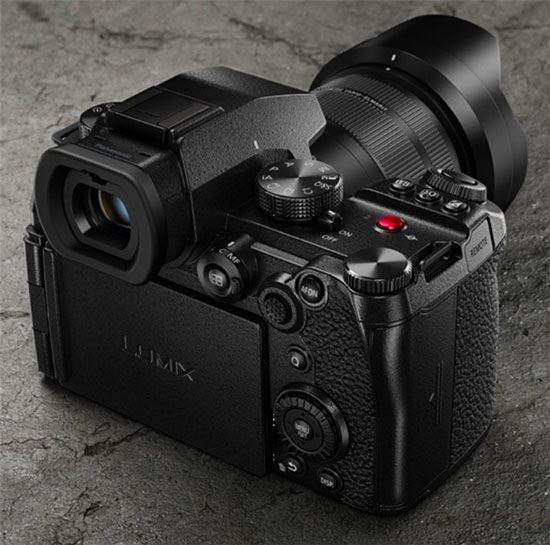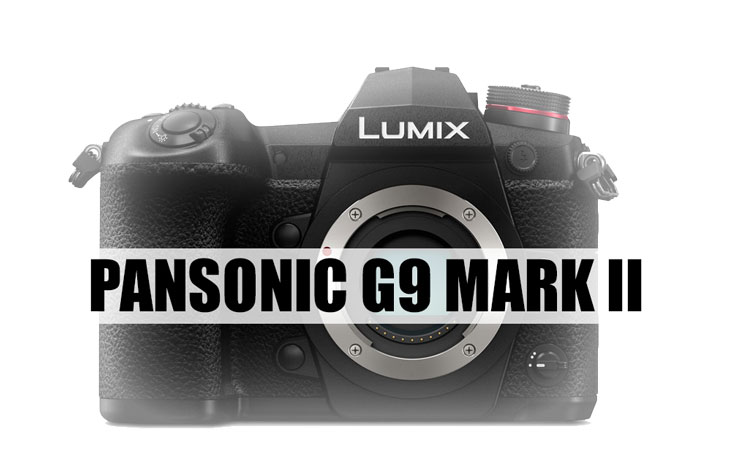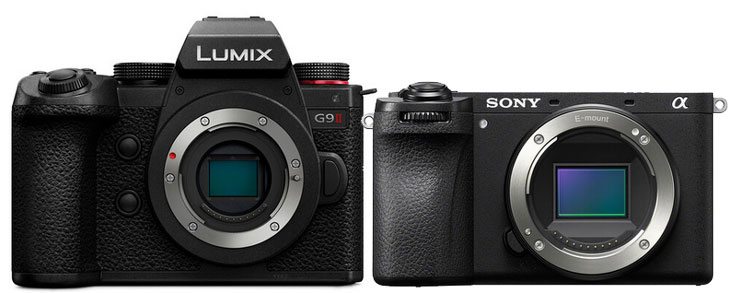
Panasonic recently announced the Panasonic G92 camera. According to Panasonic, the camera features a major upgrade. The camera is dedicated to still photography, but after looking at its core video specifications, it can also become a perfect companion for cinematographers.
We are comparing the Sony A6700 camera with the Panasonic G92. Based on the major code differences, which camera should you pick for cinematography or for photography? You will get a clear set of answers in this article.
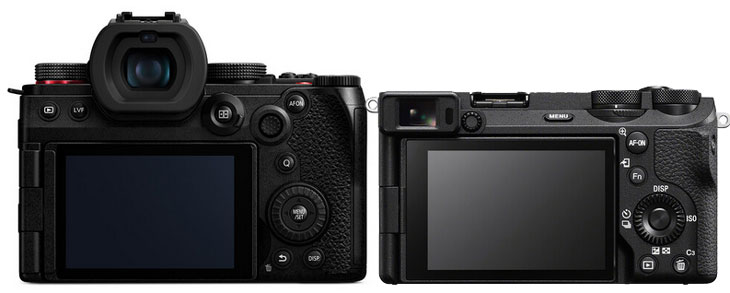
1. Panasonic G9 Mark II, has a large body but is useful for Photographers
Starting from the design part, the Panasonic G9 II camera is fairly large in size and a bit bulky (658g. 134 x 102 x 90 mm vs 493g. 122 x 69 x 75 mm) and adopts the body of the Panasonic S5 Mark II camera. The body design and control type of electronics you find is almost identical to that of its full-frame S5 Mark II.
When compared to the design part of the Sony A6700 camera, the first and foremost thing you will notice is the presence of a large electronic viewfinder in the center of the camera. As a photographer, I would love to have a perfectly placed viewfinder on a camera.
| Sensor Size | Micro Four Thirds | Sony E APS-C Format Sensor |
| Sensor Resolution | Actual: 26.52 Megapixel Effective: 25.21 Megapixel |
Actual: 27 Megapixel Effective: 26 Megapixel (6192 x 4128) |
| Image Sensor | 17.3 x 13 mm (Four Thirds) MOS | 23.3 x 15.5 mm (APS-C) CMOS |
| Crop Factor | 2x | 1.5x |
| Image Stabilization | Sensor-Shift, 5-Axis | Sensor-Shift, 5-Axis |
| Built-In ND Filter | None | None |
| Capture Type | Stills & Video | Stills & Video |
2. More Customizable Controls and Dial in Panasonic G9 Mark II
The Panasonic G9 II has more customizable controls and dials, not only on the top side of the camera but also on the rear side. We have a joystick controller on the back side of the Panasonic G9 so we can easily jump to the setting we want to. No joystick controller is present on the rear side of the Sony A6700 camera.
3. Dual Card Slot and Full-Size HDMI in Panasonic G9 II
Dual card slot support is available with the Panasonic G9 II camera, whereas the Sony A6700 camera is limited to a single card slot. At the same time, we also have a full-size HDMI port in G9 Mark II.
4. APS-C vs M4/3 Format Sensor
When it comes to sensor size comparison, the Sony a6700 camera features a large APS-C size sensor. Without a doubt, with a larger sensor and slightly higher resolution, we will have more details in standard shooting modes. Due to the nature of the physical sensor size, the low-light performance of the Sony a6700 camera is expected to be better in low-light shooting environments when compared to the Panasonic G92.
5. Pixel Shift Hand Held High Resolution Mode in Sony
High Resolution Handheld Mode The High Resolution Handheld mode isn’t a new feature for Panasonic cameras; it was introduced with the Panasonic GH6. With the help of pixel shift technology, this mode allows a photographer to capture 100-megapixel images without the need for a tripod. We’ve added some samples to give an idea of how the handheld high-resolution mode works in Panasonic cameras. For reference, we’ve taken images with the Panasonic GH6 camera and compared them to those from the Sony a6700 camera.
Standard Shooting Condition
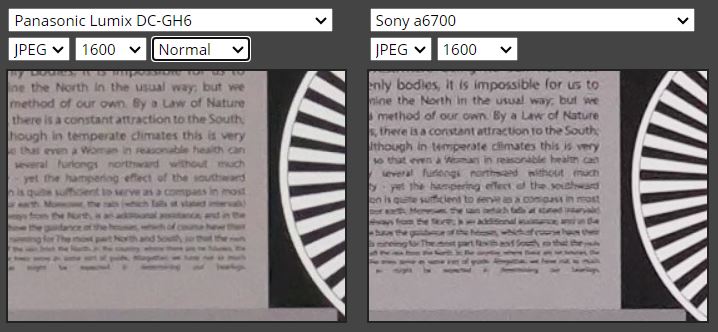
Pixel Shift Shooting @ 100Mp [ Panasonic GH6 taken as example here]
In the pixel shift mode, as you can notice the camera is able to extract an amazing amount of details even while using it handheld
![]()
High-Resolution Sample 2
ISO 1600, you can see the amount of detail Panasonic cameras are able to extract when compared to a 24-megapixel camera like Sony a6700.
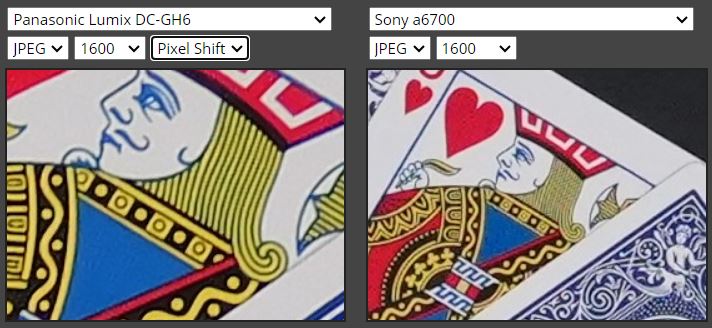
| Shutter Type | Electronic Shutter, Mechanical Focal Plane Shutter | Electronic Shutter, Mechanical Focal Plane Shutter |
| Shutter Speed | Mechanical Shutter 1/8000 to 60 Seconds Up to 30 Minutes in Bulb Mode Electronic Shutter 1/32000 to 60 Seconds Up to 60 Seconds in Bulb Mode Electronic Front Curtain Shutter 1/2000 to 60 Seconds Up to 30 Minutes in Bulb Mode |
Mechanical Shutter 1/4000 to 30 Seconds Electronic Shutter 1/8000 to 30 Seconds |
| Bulb/Time Mode | Bulb Mode | Bulb Mode |
| ISO Sensitivity | Photo 100 to 25,600 (Extended: 50 to 25,600) Video 100 to 12,800 (Extended: 50 to 12,800) |
Photo 100 to 32,000 in Manual Mode (Extended: 50 to 102,400) 100 to 6400 in Auto Mode Video 100 to 32,000 in Manual Mode 100 to 6400 in Auto Mode |
| Metering Method | Center-weighted average, Highlight Weighted, Multiple, Spot | Center-weighted average, Multi-Zone, Spot |
| Exposure Modes | Aperture Priority, Auto, Manual, Program, Shutter Priority | Aperture Priority, Auto, Manual, Program, Shutter Priority |
| Exposure Compensation | -5 to +5 EV (1/3 EV Steps) | -5 to +5 EV (1/3, 1/2 EV Steps) |
| Metering Range | 0 to 18 EV | -3 to 20 EV |
| White Balance | 2500 to 10,000K Presets: AWB, Cloudy, Color Temperature, Daylight, Flash, Incandescent, Shade, White Set 1, White Set 2, White Set 3, White Set 4 |
2500 to 9900K Presets: ATW, AWB, Auto, Cloudy, Color Temperature, Color Temperature Filter, Custom, Daylight, Flash, Fluorescent (Cool White), Fluorescent (Day White), Fluorescent (Daylight), Fluorescent (Warm White), Incandescent, Shade, Underwater |
| Continuous Shooting | Mechanical Shutter Up to 14 fps at 25.2 MP for up to 170 Frames (Raw) / 200 Frames (JPEG) Electronic Shutter Up to 75 fps at 25.2 MP for up to 200 Frames (Raw) / 200 Frames (JPEG) |
Up to 11 fps at 26 MP for up to 59 Frames (Raw) / 1000 Frames (JPEG) |
| Interval Recording | Yes | Yes |
| Self-Timer | 2/10-Second Delay | 2/5/10-Second Delay |
6. The burst speed and Pre-Shooting Buffer
The Panasonic G9 Mark II camera includes features such as a pre-shooting buffer, which you can set the time frame for. When discussing mechanical shutter speed in continuous burst, the G9 Mark II can achieve up to 14 frames per second. If we switch to electronic, it can reach a maximum of 60 frames per second with full-time auto-focus support. Without continuous auto-focus, the G9 Mark II can reach a maximum burst speed of 75 frames per second.
Focus
| Focus Type | Auto and Manual Focus | Auto and Manual Focus |
| Focus Mode | Continuous-Servo AF, Manual Focus, Single-Servo AF | Automatic, Continuous-Servo AF, Direct Manual Focus, Manual Focus, Single-Servo AF |
| Autofocus Points | Phase Detection: 779 | Photo Phase Detection: 759 Video Phase Detection: 495 |
| Autofocus Sensitivity | -4 to +18 EV | -3 to +20 EV |
7. Hybrid AF – Sony is the Beast, G9 Mark II Reliable
One of the biggest advantages of the G9 Mark II camera is that for the first time, we have a sensor that is equipped with 779 hybrid auto-focusing points. This significantly improves the focusing performance of the camera compared to its predecessor. Now, the camera is able to track cars, animals, and planes.
While the Sony a6700 camera with dedicated artificial intelligence will perform more precisely and accurately in terms of auto-focusing performance since the camera is now backed by the AU Chip and Sony is making of the Hybrid AF sensors from generations. For the first time, Panasonic introduced HYBRID AF in the G9 Mark II is also very useful for general purposes shooting and tracking moving subjects. The auto-focus system in the G9 Mark II is much better than the previous generation’s Depth from Defocus (DFD) auto-focus system.
Verdict: Panasonic G9 Mark II vs Sony A6700 – Best Camera for Photographers
Despite the fact that the Panasonic G9 Mark II camera has a small sensor, it is still capable of producing approximately 100-megapixel detailed images due to its handheld high-resolution mode. This makes the G9 Mark II one of the most suitable cameras for studio photographers who capture images in a controlled environment or work with models.
However, for those who often work in candid situations, such as wedding photographers or street shooters, the G9 Mark II’s handheld high-resolution mode may not be as effective. This is particularly true in cases where subjects are constantly moving, including wildlife and sports photography. In these specific scenarios, it is recommended to consider alternatives like the Sony a6700 or Canon R10, which offer higher continuous burst speeds.
Get Panasonic G9 Mark II from B&H Store | amazon.com
Get a Sony A67o0 camera from B&H Store | Amazon.com
| Internal Recording Modes | H.264 ALL-Intra/H.265 Long GOP 4:2:2/4:2:0 8/10-Bit 5760 x 4320 at 23.98/24.00/25/29.97 fps [200 Mb/s] 5728 x 3024 at 23.98/24.00/25/29.97/47.95/48.00/50/59.94 fps [200 to 300 Mb/s] 4352 x 3264 at 47.95/48.00/50/59.94 fps [300 Mb/s] 4096 x 2160 at 23.98/24.00/25/29.97/47.95/50/59.94/100/120 fps [150 to 600 Mb/s] 3840 x 2160 at 23.98/24.00/25/29.97/47.95/50/59.94/100/120 fps [72 to 600 Mb/s] 1920 x 1080 at 23.98/24.00/25/29.97/47.95/50/59.94/100/120/200/240/300 fps [20 to 400 Mb/s] ProRes 422/ProRes 422 HQ 1920 x 1080 at 23.98/24.00/25/29.97/50/59.94 fps [121 to 454 Mb/s] |
XAVC HS 4:2:2 10-Bit UHD 4K (3840 x 2160) at 23.98/50/59.94/100/120 fps [50 to 280 Mb/s] XAVC HS 4:2:0 10-Bit UHD 4K (3840 x 2160) at 23.98/50/59.94/100/120 fps [30 to 200 Mb/s] XAVC S 4:2:2 10-Bit UHD 4K (3840 x 2160) at 23.98/25/29.97/50/59.94/100/120 fps [100 to 280 Mb/s] 1920 x 1080 at 23.98/25/29.97/50/59.94 fps [50 Mb/s] XAVC S 4:2:0 8-Bit UHD 4K (3840 x 2160) at 23.98/25/29.97/50/59.94/100/120 fps [60 to 200 Mb/s] 1920 x 1080 at 23.98/25/29.97/50/59.94/100/120 fps [16 to 100 Mb/s] XAVC S-I 4:2:2 10-Bit UHD 4K (3840 x 2160) at 23.98/25/29.97/50/59.94 fps [240 to 600 Mb/s] 1920 x 1080 at 23.98/25/29.97/50/59.94 fps [89 to 222 Mb/s] |
| External Recording Modes | 4:2:2 10-Bit via USB 5728 x 3024 at 23.98/24.00/25/29.97 fps 4096 x 2160 at 23.98/24.00/25/29.97/47.95/50/59.94 fps 3840 x 2160 at 23.98/24.00/25/29.97/47.95/50/59.94 fps |
4:2:2 10-Bit via HDMI UHD 4K (3840 x 2160) at 23.98/25/29.97/50/59.94 fps HD (1920 x 1080) at 23.98/50/59.94 fps |
| Fast-/Slow-Motion Support | Yes | Yes |
| Gamma Curve | HDR-HLG, Panasonic V-Gamut, Panasonic V-Log | HDR-HLG, S Cinetone, Sony S-Log 3 |
| Recording Limit | None | None |
| Broadcast Output | NTSC/PAL | NTSC/PAL |
| IP Streaming | None | None |
| Built-In Microphone Type | Stereo | Stereo |
| Audio Recording | MOV: 2-Channel 24-Bit 48 kHz LPCM Audio MP4: 2-Channel 16-Bit 48 kHz AAC Audio |
XAVC: 2-Channel 16-Bit 48 kHz LPCM Audio |
8. Best Camera for Video
The Sony A6700 comes with a host of impressive features:
- Full pixel readout from the 6K sensor for high-quality UHD 4K video, minimizing moiré and aliasing.
- UHD 4K recording with frame rates up to 120p and full HD recording up to 240p, using full 1:1 pixel readout without binning.
- Advanced XAVC HS and XAVC S-I formats for recording in 10-bit 4:2:2, providing consistent performance and quality at bitrates up to 600 Mb/s.
- The S-Log3 and S-Gamut3.Cine Gamma Curves offer more than 14 stops of dynamic range for increased post-production flexibility, including matching video from other Sony Cinema Line cameras.
- User-created LUTs and presets can be set for accurately monitoring footage or previewing a specific look during shooting. These can be applied to the camera’s monitor, EVF, or HDMI out.
- AI Autoframing for content creators.
- The ability to record for more than two hours in 4K 30p, or more than 40 minutes at 4K 60p on a 128GB card.
Panasonic G9 Mark II Features
- DCI 4K and UHD 4K 60p UNCROPPED unlimited recording with 4:2:2 10-bit color, and for videographers who want to create high-resolution slow-motion video, the camera also supports C4K/4K 120p video capture with 4:2:0 10-bit color.
- AWB Lock mode locks in auto white balance and Advance Autofocus MODE to rack focus motion picture effect.
- Supports ProRes 422 codec delivering outstanding image quality with low compression. performance and quality at bitrates up to 800 Mb/s.
- Real Time LUT video recording to streamline your workflow and color grading.
- Recording and playback is supported using an external SSD via USB. Additionally, you have the ability to record ProRes 422 HQ and 4:2:2 10-bit All-Intra directly to an SSD, which combines portability and high capacity for improved efficiency in data backup and post-processing.
- Larger Body the same heatsink unit as of the Panasonic S5 Mark II.
Verdict: Best Camera for Video Panasonic G9 Mark II vs. Sony A6700
The Panasonic G9 Mark II camera is highly usable for professional cinematography work. These features include direct recording to SSD drives, 4K 60fps uncropped recording mode, a heat sink mechanism similar to the S5 Mark II camera, ProRes mode, and bit rates up to 800 megabytes per second.
For content creators who produce short videos for their YouTube channels, the Sony a6700 camera may be more suitable due to its AI auto-framing technology, which is undoubtedly highly beneficial for content creators working alone.
The introduction of a hybrid cinema auto-focus sensor in the Panasonic G9 Mark II has significantly improved its auto-focusing performance in video. Additionally, the introduction of 8 stops of image stabilization helps to create handheld content in a much better way compared to previous generations of Panasonic mirrorless cameras.
One of the most notable features of the G9 Mark II is its larger body with a better heat sink mechanism, similar to the Panasonic S5 Mark II. This ensures that the camera can operate for extended periods without overheating.
Get Panasonic G9 Mark II from B&H Store | amazon.com
Get a Sony A67o0 camera from B&H Store | Amazon.com
| Media/Memory Card Slot | Dual Slot: SD/SDHC/SDXC (UHS-II) | Single Slot: SD/SDHC/SDXC (UHS-II) |
| Video I/O | 1 x HDMI (Unspecified Signal) Output | 1 x Micro-HDMI (Unspecified Signal) Output |
| Audio I/O | 1 x 1/8″ / 3.5 mm TRS Stereo Headphone Output on Camera Body 1 x 1/8″ / 3.5 mm TRS Stereo Microphone Input on Camera Body |
1 x 1/8″ / 3.5 mm TRS Stereo Headphone Output 1 x 1/8″ / 3.5 mm TRS Stereo Microphone Input |
| Power I/O | 1 x USB-C Input/Output | 1 x USB-C Input/Output |
| Other I/O | 1 x USB-C (USB 3.2 / 3.1 Gen 2) Data/Video Input/Output (Shared with Power Input) | 1 x USB-C (Shared with Power Input) |
| Wireless | 2.4 / 5 GHz Wi-Fi 5 (802.11ac) Bluetooth 5.0 |
2.4 / 5 GHz Wi-Fi 5 (802.11ac) Bluetooth 4.2 |
| Mobile App Compatible | Yes: Android & iOS App Name: LUMIX Sync Functionality: Access Stored Files, Adjust Settings, Firmware Update, Remote Control *As of September 2023: Check with the manufacturer for the most up-to-date compatibility |
Yes: Android & iOS App Name: Creators’ App Functionality: Access Stored Files, Remote Control *As of July 2023: Check with the manufacturer for the most up-to-date compatibility |
| Global Positioning (GPS, GLONASS, etc.) | GPS *Via Connected Smartphone |
GPS *Via Connected Smartphone |
| Battery Type | 1 x DMW-BLK22 Rechargeable Lithium-Ion, 7.2 VDC, 2200 mAh (Approx. 370 Shots) | 1 x NP-FZ100 Rechargeable Lithium-Ion (Approx. 550 Shots) |
| Shoe Mount | 1 x Hot Shoe | 1 x Intelligent Hot Shoe |
| Tripod Mounting Thread | 1 x 1/4″-20 Female (Bottom) | 1 x 1/4″-20 Female (Bottom) |
| Material of Construction | Magnesium Alloy | Magnesium Alloy |
| Dimensions (W x H x D) | 5.3 x 4 x 3.5″ / 134.3 x 102.3 x 90.1 mm (Without Protrusions) | 4.8 x 2.7 x 3″ / 122 x 69 x 75.1 mm |
| Weight | 1.4 lb / 658 g (With Battery, Recording Media) 1.3 lb / 575 g (Body Only) |
1.1 lb / 493 g (With Battery, Recording Media) 0.9 lb / 411 g (Body Only) |
Get Panasonic G9 Mark II from B&H Store | amazon.com
Get a Sony A67o0 camera from B&H Store | Amazon.com

